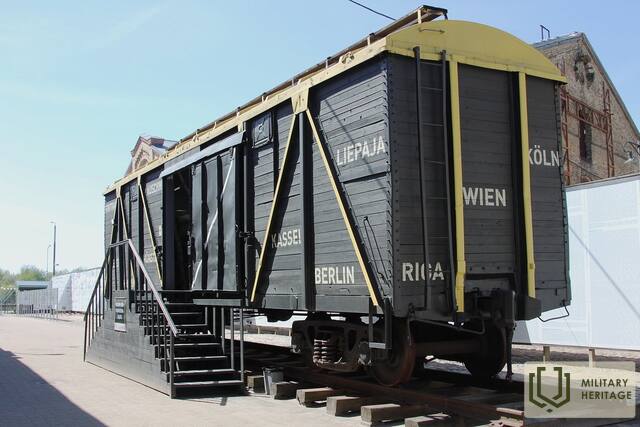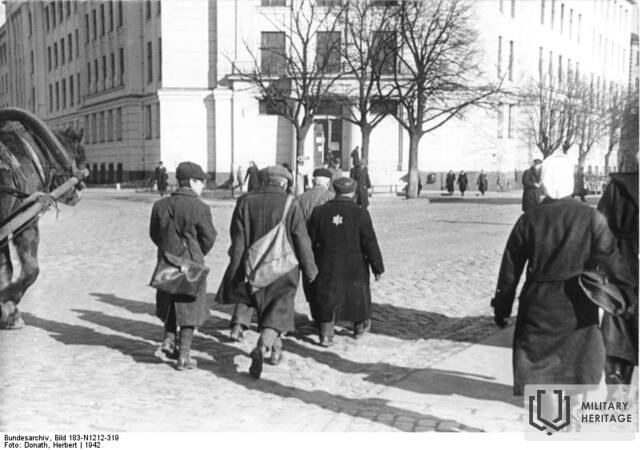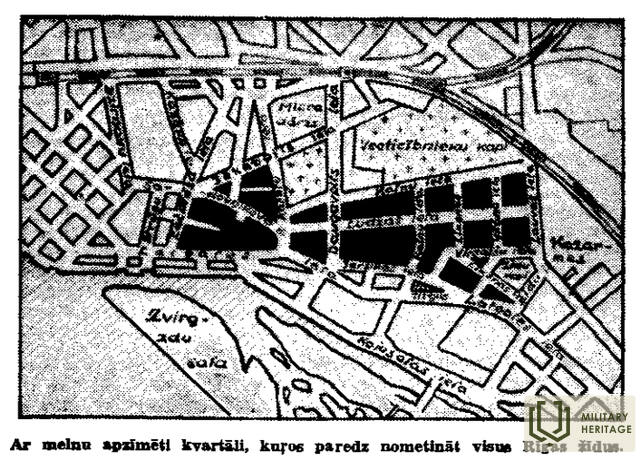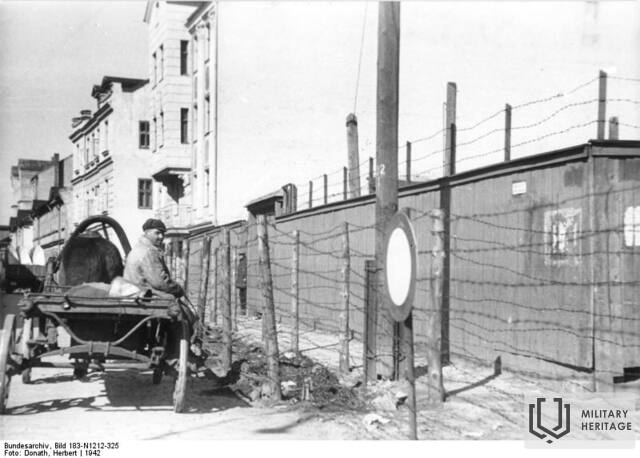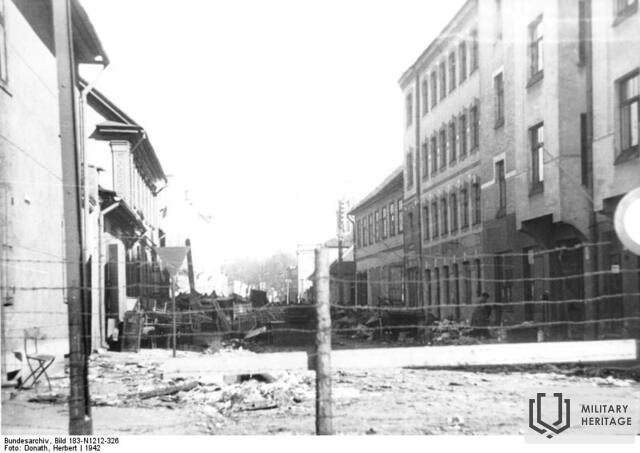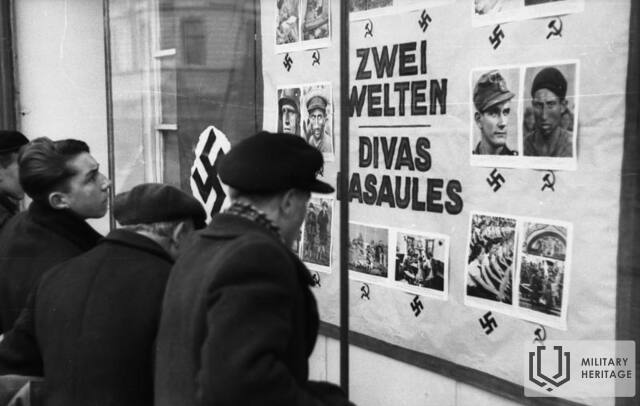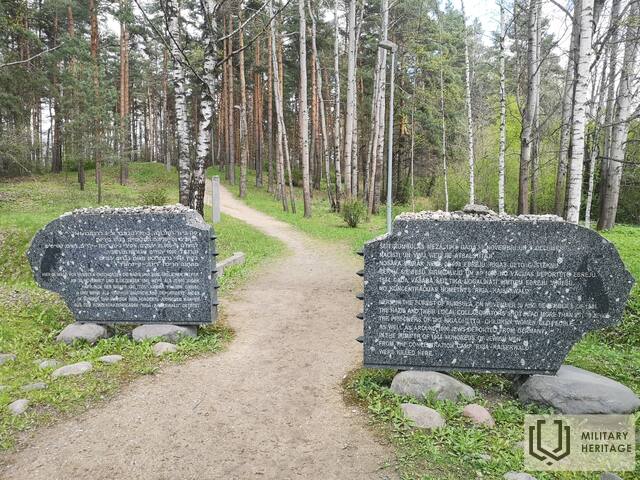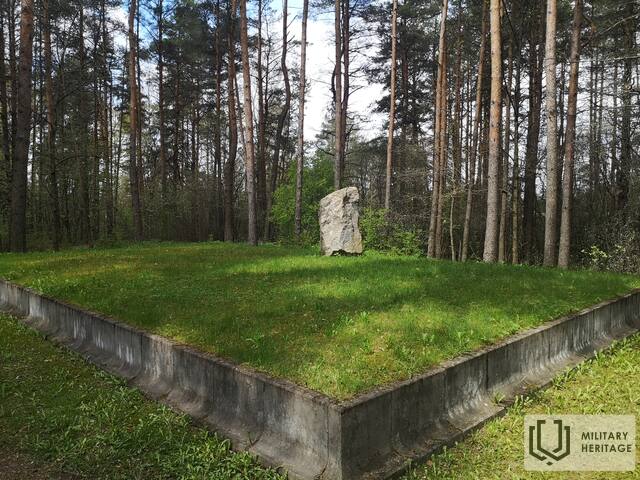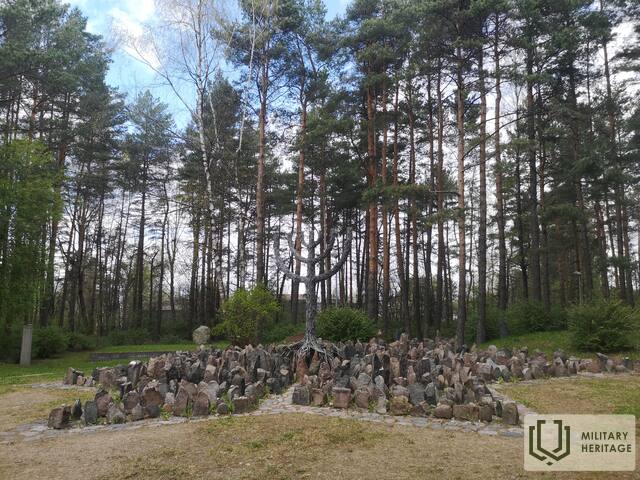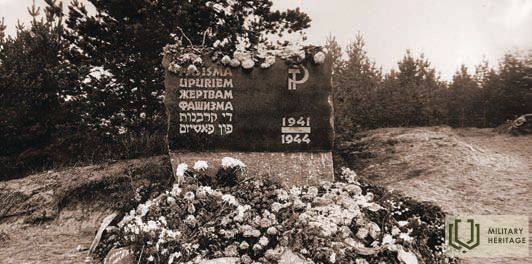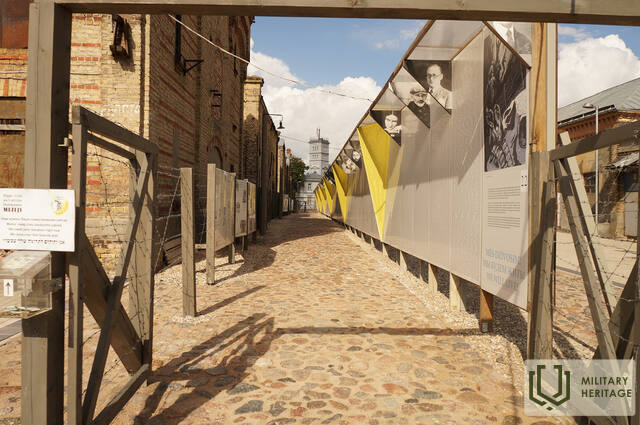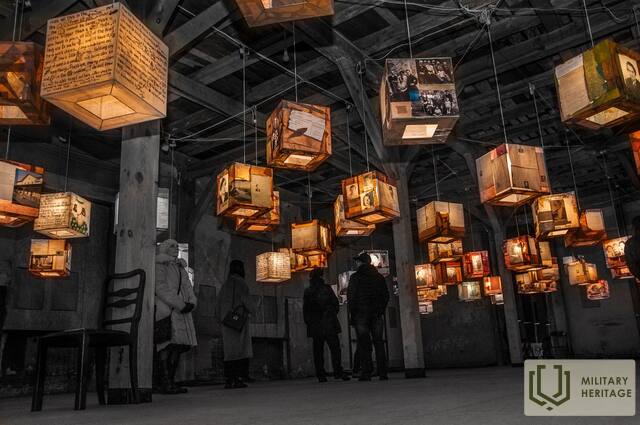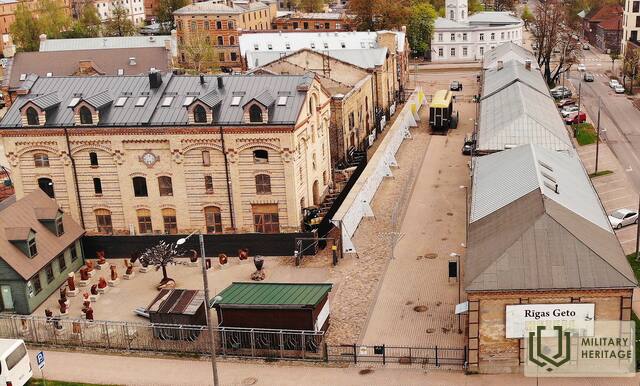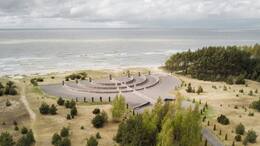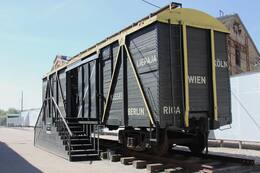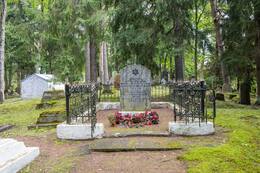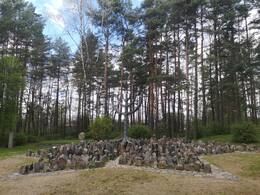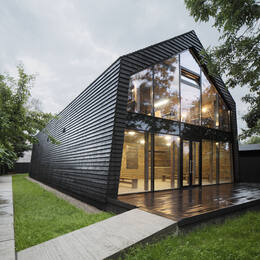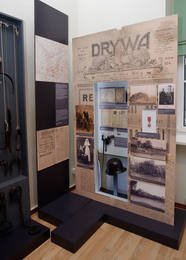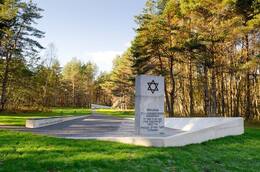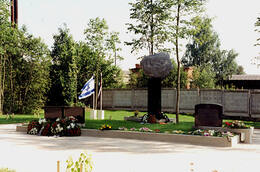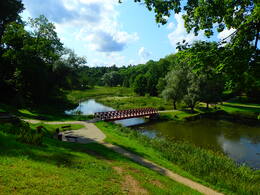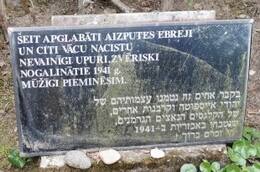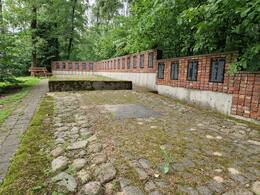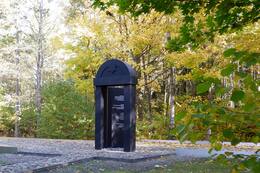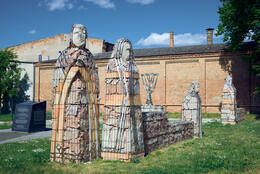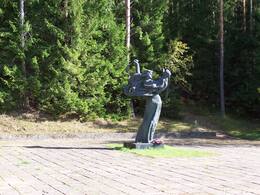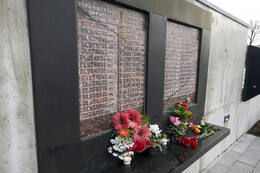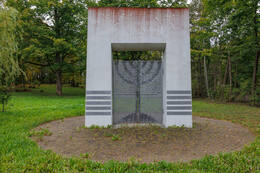Holokaustas II WW2
Holokausts (grieķu val. holos – viss, bez atlikuma; kaustos – sadedzināts) – ebreju masveida iznīcināšana nacistiskajā Vācijā un tās okupētajās teritorijās Otrā pasaules kara laikā. Ebreju masveida iznīcināšanas process sākās līdz ar Polijas okupāciju. Līdz ar Vācijas iebrukumu Padomju Savienībā 1941. gada 22. jūnijā sākās holokausta jeb šoā (katastrofas) aktīvā fāze. Nacistu slepenais t.s. “ebreju jautājuma galīgais atrisinājums” (Endlösung der Judenfrage) paredzēja nogalināt visus PSRS teritorijā dzīvojošos ebrejus. 1930. gadu otrajā pusē Latvijā dzīvoja 93 479 ebreji (1935). Latvijā tika nogalināta arī lielākā daļa uz šejieni kara laikā deportēto Vācijas, Austrijas, Ungārijas un Čehoslovākijas ebreju. Genocīds tika vērsts arī pret Latvijas romiem un garīgi slimajiem. Holokausts ir lielākais pret civiliedzīvotājiem pastrādātais masveida noziegums Latvijas vēsturē – nacistiskās okupācijas laikā aizgāja bojā aptuveni 73 000 Latvijas ebreju un 16 000 ārzemju ebreju.
Holokausta īstenošanu vācu okupētajā Latvijā sākotnēji veica Vācijas drošības policijas un SD speciālā vienība Einsatzgruppe A – lielākā no četrām šādām einzacgrupām. To vadīja SS brigādes ģenerālis un policijas ģenerālmajors Valters Štālekers (Stahlecker). Sākumā tika ieviesti dažādi ierobežojumi un aizliegumi, pēc tam notika ebreju reģistrācija, viņiem uz apģērba obligāti bija jāuzšuj jūdaisma simbols – sešstaru Dāvida zvaigzne. Ebrejiem konfiscēja īpašumus, tam sekoja viņu izolēšana un galu galā noslepkavošana. Pirmās slepkavības notika jau 1941. gada 23. jūnijā Grobiņā. Vācu militārajām un civilajām iestādēm bija nepieciešams iedibināt savu varu un veikt vietējo iedzīvotāju iesaistīšanu slepkavībās. Tās notika visās apdzīvotajās vietās, kur bija kaut niecīgs ebreju iedzīvotāju skaits. Slepkavību galvenie veicēji bija īpaši izveidotas SD vienības Viktora Arāja un Mārtiņa Vagulāna vadībā.
Tika nodedzinātas jūdaistu kulta celtnes – sinagogas, jau 4. jūlijā Rīgā tika nodedzināta 19. gs. otrajā pusē celtā horālā sinagoga Gogoļa ielā. 23. augustā Maskavas priekšpilsētā tika izveidots geto, kur tika sadzīti 29 602 cilvēki. Daugavpils geto ievietoja 14 000, vairākus tūkstošus arī Liepājas geto. 1941. gada 30. novembrī un 8. decembrī viņa vadībā Rumbulā tika nogalināti aptuveni 25 000 Latvijas un 1000 no Vācijas atvesto ebreju. Pēc Rumbulas slaktiņa dzīvi bija palikuši spaidu darbos nodarbinātie aptuveni 6000 ebreju. 1944. gadā izdzīvojušie tika deportēti uz nometnēm Vācijā. Vācu nacistiskā okupācijas vara īstenoja genocīdu arī pret Latvijas romu (čigānu) tautas pārstāvjiem un garīgi slimajiem. Vairākās Latvijas pilsētās tika nonāvēti aptuveni 2000 romu, psihiatriskajās slimnīcās Rīgā, Daugavpilī, Liepājā, Strenčos u.c. – aptuveni 2327 cilvēku.
Daugiau informacijos šaltinių
http://okupacijasmuzejs.lv/lv/aktualitates/4-julijs--ebreju-tautas-genocida-upuru-pieminas-diena-379/
Saistītās laikalīnijas
Saistītie objekti
Memorial to the victims of holocaust in Liepāja
The largest memorial to Holocaust victims in Latvia is located in Liepāja, in the Šķēde dunes. The memorial is dedicated to the memory of more than 3,000 Liepāja Jews killed during World War II. It is in the form of the Israeli national symbol, a seven-branched candelabra known as the menorah. The contours of the memorial, which are clearly visible from a bird’s eye view, are made of split boulders and granite blocks. The ‘lights’ of the menorah are made of granite pillars with inscriptions of verses from the Lamentations of Jeremiah in Hebrew, English, Latvian and Russian.
Riga Ghetto and Latvian Holocaust Museum
The Riga Ghetto and the Latvian Holocaust Museum is located in Riga close to the Riga Central Market and the Riga Central Station. The museum was opened in 2010 on the site where the city's warehouses once were. It is located in the historical part of the city, next to the border of the former Jewish ghetto. The territory of the ghetto is unique, because in terms of architecture it has not changed since World War II. It is a memorial dedicated to the tragedy suffered by the Jewish people. The German policy regarding the Jewish population in Latvia until the end of 1939 was for the German diplomats and politicians to try and pressure the Latvian government to take action against the Jews by restricting their freedom. After the emigration of the Baltic Germans in 1939, the German embassy no longer had as good an access to information on the mood of the population and the events happening in Latvia as before. When the Red Army occupied Latvia, they manipulated the society to gain some support of the Jewish population for the new occupying power. However, after the regime started a crackdown on the society as a whole, the support fell rapidly. As a result of all this, a deep divide had formed between the people. And later on, the next regime – Germany – tried to exploit it. They hoped that the local population would harass and attack the Jews, but that did not happen. So, Germany adjusted their approach and devised a new plan to initially establish a Jewish ghetto and later destroy its inhabitants.
Varaklani Jewish Cemetery - a memorial to the victims of German-fascist terror
Varakļāni Jewish Cemetery, at the end of Kapsētas Street.
There are two monuments erected in the Varakļāni Jewish cemetery after the war by surviving relatives and relatives.
One of them is located near the cemetery fence, where the mass extermination of Jews took place. The inscription on it in Russian and Yiddish reads: "We will mourn forever with our parents, brothers and sisters who died at the hands of the fascists in 1941." The second monument is inside the cemetery; In the place where the killed Jews were later reburied, there is also an inscription in Yiddish and Russian: "Eternal memory of the victims of the German-fascist terror - the Jews of Varakļāni, brutally killed on August 4, 1941".
Nazi German troops entered Varaklani in 1941. In early July, and from the very first days, the siege and isolated killings of Jews began. A conditional ghetto was established near the Jewish cemetery, to which all Jews had to move. On August 4, a German SD unit (the "Arāja team") shot virtually all Jews in Varakļāni (about 540 people) with the help of local self-defense forces on the territory of the Jewish cemetery.
Every year on the first Sunday of August, a memorial event dedicated to the Jews killed in Varakļāni takes place in the Varakļāni Jewish Cemetery.
Jewish Memorial at Rumbula
Located in Rumbula, near Moskava Street.
Rumbula is one of the largest sites of mass extermination of Jews in Europe. During two actions - 1941. On November 30 and December 8, which were realized based on the Nazi leadership's decision to completely exterminate the Jews imprisoned in the Riga ghetto, more than 25,000 people were shot in the Rumbula forest, including approximately 1,000 Jews deported from Germany. 1944 Several hundred Jewish men from the Kaiserwald concentration camp were also killed in Rumbula.
The first attempts to perpetuate the memory of the Jews killed in Rumbula date back to the end of the 60s. Despite the restrictions of the Soviet government, as a result of the initiative of some Jews in 1963. a wooden commemorative plaque with an inscription in Yiddish was attached to one of Rumbula's pine trees, while a large poster of the artist Josif Kuzkovskis "The Jew" was installed near the Rumbula railway (near the Riga-Moscow line). The poster showed the image of a man rising from the grave with a clenched fist, symbolizing a protest against what had been done. Both the commemorative plaque and the poster already in 1964. were harvested, but the Jews managed to obtain permission to erect a memorial stone in Rumbula with the inscription "Victims of Fascism" not only in Latvian and Russian, but also in Yiddish.
in 2002 On November 29, the memorial ensemble was opened in Rumbula according to the project of architect Sergejs Riž. Its establishment was financially supported by the institutions of Latvia, Israel, the USA and Germany, as well as private individuals.
On the side of the highway, by the road that leads to the memorial, a metal structure symbolizing the forces of Nazism has been installed as a sign. Nearby is a stone with the explanation that thousands of Jews were chased to death along this road. At the entrance to the memorial itself, several stone plaques with inscriptions in Latvian, English, German and Hebrew introduce the events of the Rumbula tragedy and the history of the establishment of the memorial. In the central part of the memorial, above the square, which is made in the shape of the Star of David, rises a seven-branched candlestick - a menorah, surrounded by stones with engraved names of the Jews killed in Rumbula. The names of the streets of the former Riga ghetto are engraved in individual stones with which the square is paved. There are several mass graves on the territory of the memorial, the places of which are marked with rectangular concrete borders.
Žanis Lipke Memorial
The Žanis Lipke memorial is located in Ķīpsala, Riga. The Žanis Lipke Museum is probably one of the most hidden museums in Riga. The obscure location of the memorial is not a coincidence and it has a symbolic meaning. It has been set up in the location of a former underground hideout that was created to save people during the German occupation of World War II. Here Žanis Lipke and his family rescued 55 Jews. Nowadays a memorial has been built next to the Žanis Lipke family house. The memorial ‘Black Shed’ is a symbolic building where shelter was provided and received. The design of the building has been taken from the historical tarred huts of Ķīpsala fishermen and sailors. These huts were built using materials from barges; hence they had a very distinct colour and tar smell. But not only the story of this historic place is unique. The way the museum communicates its message is also quite notable. The overall design has similarities with the Noah’s Ark described in the Bible, and it also resembles a boat that has been pulled ashore and overturned – a boat that has fulfilled its task. The concept of this memorial draws from the historic accuracy of this place and story and the testimonies associated with it. It is a story of a desire for freedom, unbelievable escape and trust. On your way to the museum, you’ll also be able to see the historic buildings of Pārdaugava.
Preiļi Museum of History and Applied Art exhibition "Museum stories for Latvia"
It is located in the premises of the Preiļi Cultural Center.
Preiļi Museum of History and Applied Art (PVLMM) exhibition "Museum stories for Latvia" about the First World War, the War of Independence and the Second World War can be viewed.
The "Story of Drywys" section of the exhibition "Museum Stories for Latvia" (opened in 2018) of the Museum of Preiļi History and Applied Arts is dedicated to the First World War, the War of Independence and the liberation of Latgale, as well as to the knights of the Lāčplešana War Order. The exhibition section "The story of the flag" tells about the difficult events of the Second World War period, during which the people of Preila were affected by deportations, the Holocaust, involvement in the military units of the warring parties, and after the war - in the ranks of national partisans. The "Righteous Among the Nations" medal awarded to Vladislav Vuškānas, the savior of the Jews from Preiliat, can also be viewed.
Upon prior application, a tour is available in Russian and English.
Klooga concentration camp and Holocaust memorial
This memorial to the victims of the Holocaust is situated not far from the small borough of Klooga.
The first monument was erected here in 1951, but it essentially praised the Soviet ideology and did little to commemorate the victims of the Holocaust. In 1994, the plaques on the monument were replaced with new ones at the request of the Jewish community in Estonia so as to do justice to the victims' ethnic roots. On the 50th anniversary of the mass murder perpetrated in Klooga, a monument to the Jews killed in Estonia from 1941-1944 was unveiled 100 metres from the first monument. In 2005, a third monument was unveiled commemorating the Jews who died or were killed in the concentration camp in Klooga.
The memorial was renovated in 2013 to tie the three monuments together, with the Estonian History Museum opening an outdoor exhibition here entitled ‘Klooga camp and the Holocaust’.
Klooga concentration camp was established by the German regime in September 1943. It was a forced-labour sub-camp of the Vaivara concentration camp complex in Estonia. On 19 September 1944, one of the largest mass murders in German-occupied Estonia was committed: all of the Jews at the camp (around 2000 in total) were killed as the Red Army approached.
Preilius Holocaust Memorial
It is located in the Preiļu Jewish cemetery on Cēsu street.
The architect of the memorial is Sergejs Rizh. Opened on August 8, 2004. The memorial was built on the initiative and personal funds of Dāvid Zilbermanis (USA), a former resident of Preiļi, engineer and public worker. In 2015, another monument was added to the memorial - an arch installed at the entrance to the cemetery in the form of a symbolic gate.
The memorial is located on the edge of the Preiļi Jewish cemetery, next to the place where around 800 Jews from Preiļi and the surrounding area were killed in the summer of 1941 after the entry of Nazi German troops with the involvement of local collaborators. The diary of Sheina Gram (1926-1941), a Jewish girl from Preiļi, which she started writing on June 22 - the day the war between the USSR and Germany started - until August 8, is a testimony of the events of this time. Sheina, together with her family and other surviving Jews of Preila, was killed next to the Jewish cemetery on August 9. Thanks to the help of Vladislav Vuškānas (1887-1953) from Preili, 6 Jews from Preili managed to survive the German occupation in hiding. On the stones of the monument are engraved entries from Sheina Gram's diary, as well as words of gratitude to the savior of the Jews, Vladislav Vushkan. An urn with the names of the 750 Jews killed here is buried at the foot of the monument.
SS-relvade prügila "Seelager" ja koonduslaagris hukkunute mälestusmärk
1943. aasta lõpus hakkasid natside Saksa okupatsioonivõimud, plaanides laiendada SS-i motoriseeritud relvaüksusi, ehitama Dundaga läheduses väljaõppekohta nimega "Seelager" (merelaager). Dundaga ja Arlava kihelkondade elanikud evakueeriti harjutusvälja rajamiseks.
Laagri taristu rajamiseks asusid Dundaga läheduses mitmed koonduslaagri "Kaizervalde" filiaalid, kuhu paigutati umbes 6000 juuti erinevatest Euroopa riikidest (sealhulgas Lätist) ning umbes 1000 sõjavangi ja partisani. Paljud vangid surid hukkamiste ja kehvade elutingimuste tõttu. Osa surnutest maeti "Čiekuri" laagrisse, mis mõnede andmete kohaselt oli ka Mazirbe suunas kitsarööpmelist raudteed ehitanud juutide grupi mõrvapaik.
1944. aasta augusti alguses, pärast Nõukogude Liidu sissetungi Zemgalesse, likvideeriti väljaõppekeskus, mitu tuhat väljaõppeta SS-veeretajat saadeti tagasi Saksamaale ning komandost, instruktoritest ja koolitatud sõduritest moodustati SS-mootorbrigaad Gross, mis sai nime väljaõppekeskuse komandöri, SS-standardseersant Martin Grossi järgi. Brigaad osales 1944. aasta augustis Tukumsi lahingus ning 1944. aasta septembris Iecava ja Baldone lahingutes.
Pärast SS-üksuste lahkumist kasutati harjutusvälja infrastruktuuri Riiast ja teistest Läti piirkondadest evakueeritud juutide majutamiseks, keda kasutati jätkuvalt orjatööjõuna.
Misiņkalnsi sõjalise pärandi rada
Misiņkalnsi looduspark asub Aizpute linnas. Misiņkalns on Aizpute linna kõrgeim koht. Selle kõrgus ulatub 95,4 meetrini. Ülevalt avaneb maaliline vaade linnale. Misiņkalnsi loodusparki hakati rajama 20. sajandil. Esiteks. Pargi pindala on hetkel ca 28 ha.
Pargi territooriumil asuvad mitmed 20. sajandi sündmustega seotud kohad ja mälestusmärgid - Läti vabadussõdades langenud sõdurite mälestusstele - Lāčpleši ordu kavalerid, holokausti mälestusmärgi koht, represseeritute mälestuspaik ja langenud partisanide mälestustahvel.
Pargis saab tutvuda erinevate haruldaste liikide taimede ja istandustega ning nautida puutumatut loodust. Praegu läbivad parki renoveeritud kõnni- ja rattateed ning pargi territooriumil on motorada, kus toimuvad Läti motokrossi võistlused.
Misiņkalnsi mõisapargi kultuuri- ja ajaloopärandi põhjalikumaks tundmaõppimiseks soovitame kasutada giidi teenuseid.
Holokausti ümbermatmispaik
Natsiväed sisenesid Aizputesse 1941. aastal. 28. juunil. Juba juuli alguses lasti Dzirkali metsas ja linnapargis maha osa juute, ülejäänud linna ja lähiümbruse juudid arreteeriti ja paigutati kahte linna sünagoogi.
Pärast seda toimus kahe aktsiooni käigus juutide massiline tapmine.
Tänaseks on ümbermatmispaika paigaldatud monument heebrea- ja lätikeelse kirjaga: "Siia on maetud Aizpute juudid ja teised Saksa natside süütud ohvrid, kes tapeti 1941. aastal julmalt. Me mäletame igavesti."
Kaušėnai holokausti memoriaal
Kaušėnai holokausti ohvrite mälestusmärk on paigaldatud Kaušėnai külla (Plungė rajoon) juutide veresauna paika. Mälestusmärk on pühendatud Teises maailmasõjas hävinud Plunge ja seda ümbritsevate külade juudi kogukonna mälestusele.
Mälestusmärk rajati viimase Plunge juudi Jakov Bunka initsiatiivil. Esimene monument püstitati 1952. aastal. Teise maailmasõja ohvrite eest ning 1986.–1989 rajati ka tammepuust monumentidest mälestusmärk surnud juutide austamiseks. aastal 2011 paigaldati mälestussein, mis ehitati lammutatud Plunge sünagoogi 1800 tellisest, millest igaüks on pühendatud mõrvatud inimese mälestusele, ning plaadile on kinnitatud plaadid 1200 (1800-st) juudi teadaolevate nimedega. seina. Mälestusmärgi juurde on loodud Päästjate allee, kus eraldi nimeveergudel on kirjas natside okupatsiooni ajal Plunges ja selle ümbruses hukkamõistetud juute päästnud isikud.
aastal 1941 12.-13.juuli Kaušėnai mäele tapeti ja maeti Plunge piirkonnast umbes 1800 juuti, keda oli varem 2 nädalat jõhkrates tingimustes Plunge sünagoogis hoitud. Genotsiidipäeval sõidutati need, kes suutsid kõndida, kõndima 5 km hukkamispaika, teised veeti veoautodega eraldi rühmadena. Ohvritel kästi kaevata endale augud, misjärel nad tulistati. Teine rühm pidi surnud matma ja endale uue augu kaevama.
Mälestusmärk on Euroopa juudi rahvuse tragöödiat kajastavate kõige muljetavaldavamate mälestusmärkide esikümnes.
Juutide holokausti toimumispaik Šeduvas Pakuteniy külas
Pakuteni metsas (Radviliški rajoon), Šeduvast umbes 8 km kagus, kruusatee ääres, asub üks kolmest Šeduva juudi holokausti paigast.
Selles kohas 1941. a augustis tapeti 27 juuti, sealhulgas Sheduva viimane rabi Mordechai David Henkin. Vahepeal hukkus rahvametsas veel umbes 700 inimest.
Pärast seda, kui natsid 25. juunil 1941 Šeduva okupeerisid, aeti linna juudid juuli alguses sunniviisiliselt kodudest välja ja aeti naaberkülla Pavartyčiai, kus rajati geto. 25.-26.augustil lasti väike osa neist maha Pakuteniis, ülejäänud Liaudiškii metsas.
2014-2015 Šeduva Juudi Mälestusfondi eestvõttel puhastati tapatalgud ja tehti külastajatele juurdepääsetavaks. Pakuteniy juutide veresauna kohale on paigaldatud skulptor Romo Quintuse monument "Swiesas žvaigdas bveinė".
Šeduva juutide 1. ja 2. holokausti paigad
Šeduva I ja II holokausti paigad asuvad Liaudiškių metsas (Radviliškise rajoon), Šeduvast umbes 10 km edelas. Kruusateele on paigutatud huviväärsus.
Esimene juudi rahvusest inimeste säilmete kalmistu asub 375 m² suurusel alal, mida ümbritseb mets, millest suurem osa on kivisillutisega. Selles kohas tapeti ja maeti umbes 400 inimest. Umbes 500 m kaugusel asub teine surnuaed. Juudi rahvusest inimeste säilmed on maetud 144 m² suurusele alale. Platsi reljeef on tasane, suurem osa territooriumist on samuti kivisillutisega. Selles kohas tapeti ja maeti umbes 300 inimest.
aastal 1941 neis paikades tapeti kogu Šeduva juudi kogukond – ligi 700 inimest. Enne seda veetsid nad veel kuu aega Pavartyčiai külla rajatud getos. 25-26 august Geto elanikud viidi Rahvametsa. Väljakaevatud kaevu juures hoiti hukkamõistetuid, kelle tapsid kohalikud politseinikud ja valgekraed.
2014-2015 Šeduva Juudi Mälestusfondi eestvõttel koristati tapatalgud ja tehti külastajatele juurdepääsetavaks. Siin on 2 skulptor Roman Quintuse monumenti: "Uks" ja "Tähekiir".
Mälestusmärk "Sünagoogi aed"
See asub Bauska kesklinnas, Bauska piirkonna turismiinfokeskuse, Raekoja platsi lähedal.
Mälestusmärk "Synagogas dārzs" sündis tänu Bauska juudi järeltulijate initsiatiivile Iisraelis, USA-s ja Suurbritannias, annetustele, Bauska maanõukogu, Läti juudi koguduste ja kogukondade toetusele.
Mälestusmärgi kujundas skulptor G. Mustkunstnik, kes on ka V. Plūdonise monumendi autor. Mälestusmärk loodi endise Bauska Suure sünagoogi mõõtmetes, kivifiguurid sümboliseerivad pärast jumalateenistust sünagoogist väljuvaid juute. Mälestusmärgi keskel on sümboolne bima, millele on kirjutatud: "Pühendus Bauska juutidele, kes elasid siin sajandeid ja ehitasid selle linna ning kelle tapsid natsid ja nende kohalikud abilised 1941. aastal." Juudi rahva – Bauska juutide järeltulijate ja Bauska elanike mälestuse austamine. 1935. aastal elas Bauskas ligi 800 juuti. Pärast natside okupatsiooni juulis 1941 arreteeriti, küüditati palju juute ja umbes 700 lasti maha. Bauska Suur sünagoog hävis Teise maailmasõja ajal.
Anchupani memoriaal Teise maailmasõja ohvritele
Pühendatud natside okupatsiooni ajal tapetud Rēzekne rajooni elanikele. Alates 1941. aasta augustist lasti Ančupani mägedes maha Rēzekne ja selle ümberkaudsete külade juute, kommunistliku okupatsioonirežiimi toetajaid, punaarmeelasi jne. Hukkunute seas oli ka 203 Makašēni valla Audriņu küla elanikku, kes tapeti 3. jaanuaril 1942. aastal.
Mälestusmärk avati 27. juulil 1974. aastal. Selle autor on maastikuarhitekt Alfons Kišķis (1910–1994). Igihaljad kuused paremal pool teed sümboliseerivad mahalaskmiseks rivistatud inimesi, tee vastaspoolne kiviaed laskureid. Kõige madalamas osas - kannatuste orus - viib mahalastud inimeste ühishaudadest mööda kividega kaetud tee, mis lõpeb betoonseinaga, millel on kiri "They died to live you". Edasi tuleb trepp Dzīvības väljakule, mille kesksel skulptuuril "Õunema" on autor skulptor Rasa Kalniņa-Grīnberga (1936).
Audriņi küla ohvrite mälestuspaik
1965. aastal avatud mälestustahvel endise Rēzekne vangla juures. Pühendatud Makašēni valla Audriņi küla kolmekümnele mehele, kes 4. jaanuaril 1942 selles kohas avalikult maha lasti. Plaadile on graveeritud 30 mahalastud mehe nimed.
Veidi enne seda selgus, et Audriņi külas varjasid end põgenenud Punaarmee sõjavangid. Nende tabamisel puhkenud relvastatud kokkupõrgetes hukkus 4 abipolitseinikku. Intsidendi eest kättemaksuks andsid natside okupatsioonivõimud korralduse tappa kõik Audriņi elanikud ja küla põletada. Avalik hukkamine Rezeknes oli osa kättemaksukampaaniast.
Holokausti memoriaal
2004. aasta augustis avati Preiļis Cēsu tänaval holokausti ohvrite mälestusmärk. Arhitekt Sergejs Rižs, idee autor ja rahastaja on aga USA elanik Dāvids Zilbermanis. Mälestusmärk asub juutide tsiviilhaudade ja juudi elanikkonna laskepesade vahelisel alal.
Esimesed juudid saabusid Preiļisse 19. sajandi alguses, kui hakati moodustama Preiļi linna. 1935. aasta rahvaloenduse andmetel olid Preiļi 1662 elanikust 847 (51%) juudid. Enamik neist olid kaupmehed, käsitöölised, aga ka intelligents – arstid ja õpetajad.
Kui Saksa natsiarmee sisenes 1941. a 28. juulil, 9. ja 10. augustil hävitati üle 720 Preiļi ja lähiümbruse juudi. Pärast sõda naasis osa juute Preilisse, kuid kogukonda ei õnnestunud üles ehitada.
2013. ja 2014. aastal viisid juudi kodanike kalmistul läbi Saksa noorteühenduse LOT õpilased ja selle juht Klaus Peter Rex. Koostati kalmistu kaart. 2015. aastal avati Dāvid Zilbermanise eestvõttel tema rahastuse ja annetuste toel juudi kogukonnale mälestuskaar Preiliis, juudi kodanike kalmistu sissepääsu juures, teel holokaustiohvrite memoriaali juurde.
2018. aastal tegi ühendus "Preiļu memoriaalid" (esimees Sergejs Rižs) kaevetöid juutide tapmispaigas juudi kodanike kalmistu kõrval. Avastati kolm süvendikohta. Pärast konserveerimist saab esemelisi tõendeid vaadata Preiļi ajaloo- ja tarbekunstimuuseumi põhinäitusel aadressil Rainiš bulvāri 28. Muuseumi spetsialistid pakuvad külastajatele haridusprogrammi "Mõelda holokaustile tähendab mõelda iseendale". Programm algab muuseumi ekspositsioonist ja lõpeb holokausti memoriaali juures. Mälestusmärki koos kalmistuga kasutatakse rahvahariduses vabaõhumuuseumina.
Susijusi istorija
Riia geto ja holokaust
Teadlikult on valitud kolm fragmenti erinevate inimeste mälestuste lugudest, mis võimaldavad holokaustikuritegevust lähemalt vaadelda erinevatest vaatenurkadest.
Taaveti täht Dundaghi koonduslaagri mälestusmärgil
Pärast taasiseseisvumist paigaldasid Dundaga elanikud juutide mõrva- ja ümbermatmispaika Mazirbe - Dundaga maantee äärde suure puust Taaveti tähe ning hiljem avas Läti Juudi Koguduste ja Koguduste Nõukogu selle kõrval mälestuskivi. seda.




